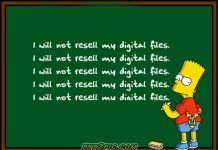 From the press release:
From the press release:
Amazon today announced Kindle Library Lending, a new feature launching later this year that will allow Kindle customers to borrow Kindle books from over 11,000 libraries in the United States. Kindle Library Lending will be available for all generations of Kindle devices and free Kindle reading apps.
…
Customers will be able to check out a Kindle book from their local library and start reading on any Kindle device or free Kindle app for Android, iPad, iPod touch, iPhone, PC, Mac, BlackBerry, or Windows Phone. If a Kindle book is checked out again or that book is purchased from Amazon, all of a customer’s annotations and bookmarks will be preserved.
“We’re doing a little something extra here,” Marine continued. “Normally, making margin notes in library books is a big no-no. But we’re extending our Whispersync technology so that you can highlight and add margin notes to Kindle books you check out from your local library. Your notes will not show up when the next patron checks out the book. But if you check out the book again, or subsequently buy it, your notes will be there just as you left them, perfectly Whispersynced.”
With Kindle Library Lending, customers can take advantage of all of the unique features of Kindle and Kindle books, including:
…
Amazon is working with OverDrive, the leading provider of digital content solutions for over 11,000 public and educational libraries in the United States, to bring a seamless library borrowing experience to Kindle customers. “We are excited to be working with Amazon to offer Kindle Library Lending to the millions of customers who read on Kindle and Kindle apps,” said Steve Potash, CEO, OverDrive. “We hear librarians and patrons rave about Kindle, so we are thrilled that we can be part of bringing library books to the unparalleled experience of reading on Kindle.”


































Potentially great news for Kindle and Kindle App users. I suppose libraries will have to buy separate Kindle copies separate from their ePub purchases which could be the only problem given the limited budgets libraries have. There’s really no reason they couldn’t allow libraries to buy generic licenses and let patrons check out their format of choice, but somehow I’m doubtful that will happen as currently libraries have to “buy” each format they want (ePub, PDF, Mobi) if it’s available.
My local library has 9,510 ebook titles (multiple copies of many) as of right now, all ePub. I’m sure they’ll be hard pressed to keep their ePub library growing and do Kindle titles at the same rate.
Will this be available to Canadians? I will be thrilled to find it it is; but, I’m sure it will only be available to those in the US of A.
I sure hope they’ll let us donate Kindle books to our library !!
This is just what I have been waiting for. I assumed that library lending would eventually come, but leave it to Amazon to keep your annotations. I won’t use that so much for fiction, but for non-fiction, that’s an incredibly powerful feature. Currently I have to take notes from library books in OneNote. I just wonder if your notes are available after you return the book, but before you buy it. That would have made term paper writing so much easier in school. Either way this change is a pleasant surprise. I expect that I will use the library as an extended “Try it free” feature.
Interesting how these announcements always tend to be vague and they also, as has already mentioned, leave out Canadian and international users. But it demonstrates that Amazon is really listening hard to user input not with standing the continued lack of support for ePub file format.
Being one of those not believing Amazon would go this route this is a surprise. That said there is several questions not being asked.
Do these include books from the Big 6? Or is Amazon licensing/selling the Indie selfpublishers to the libraries? If the Big 6 than are they – the publishers – selling the same book or Amazon? Must libraries buy (license) the same book twice for two different formats?
If the answer to the last is yes then the financial implication for libraries can only be described as dire.
Looks like good news for libraries! Now we will just have to see who is onboard.
“There will be no additional cost to acquire new files to make them compatible”
http://www.libraryjournal.com/lj/home/890266-264/amazon_to_allow_library_lending.html.csp
Was glad to read this at the link gous provided…
“The lending will be available for all generations of the Kindle as well as Kindle reading apps, and it will integrate with all the existing ebook catalogs in the United States powered by OverDrive. In other words, the libraries—including schools, colleges and public libraries—will not have to add a new format, and the ebooks now available on the OverDrive sites will be immediately integrated with the Kindle,”
gous,
I doubt the libraries would sign off on anything that would be dire for them.
The Big 6: Macmillan and also Simon and Schuster do NOT allow their e-books to be loaned by public libraries. So, count them out.
That leaves the Big 4. HarperCollins, early on, did not participate in Amazon’s Kindle loaning program. I doubt they’ve changed that stance. I didn’t check any others. Just saw that Hachette books I had were loanable but not the HarperCollins ones.
Publisher reaction will be interesting.
This is great news- especially as it appears from the above comments, that the libraries will NOT have to buy the same book in both formats. This is Amazon watching what B & N is doing and coopting them
Good business.
Amazon’s solution is a no brainer: that is, work directly with Overdrive who already have the relationship with libraries. Amazon may bring some back office capability; they may assist in the cloud costs; but ultimately, Kindle piggybacks on the Overdrive system to ensure transactions are secure and run through Overdrive.
This is a serious long-term blow to ePub vendors as it will remove the last serious marketing differentiator that Kindle has lacked: ability to borrow a library book. (Overdirve serves library systems around the world; Canada could well benefit in the early stages.)
Congrats to Amazon!
Very curious to see whether, when this kicks in, if wait list times for popular books goes through the roof. Maybe Amazon is looking 6-7 moves ahead on the board and this is nothing but an ingenious effort to kill ALL library e-book lending by increasing the number of e-library patrons by 1000%.
Win-win for Amazon. Kindle sales go up because the “doesn’t support libraries” argument goes away, and book sales go up because true library ebook availability goes down.
When this comes out, everybody else can quit talking about library loans as a feature. Kindle users will be able to get their library e-books straight on Kindle. All of the other e-readers require their users to mess about with Adobe Digital Editions in order to get library e-books.
Sony and Kobo could, in theory at least, work out a similar arrangement with OverDrive. However, that seems like the long way around since Sony and Kobo are already using Adobe EPUB.
B&N, however, will be out in the cold because its DRM system doesn’t provide any ability to expire e-books. B&N could conceivably add the ability for their web site to allow downloading of e-books with Adobe DRM instead of B&N DRM. However, to my knowledge (a *huge* disclaimer there), NOOKs of all stripes are currently incapable of downloading *time-limited* Adobe EPUBs — those files have to be sideloaded using Adobe Digital Editions.
Impressive. This is the one thing I thought Amazon would never do, given that their bread and butter lies in selling books. I’m particularly surprised that my aging Kindle 1 is included.
There are probably two reasons for this move:
1. It removes one of the few remaining advantages of the Nook. B&N must be weeping and wailing over this news.
2. It means sales. Libraries will need to buy the ebooks from Amazon and, according to a librarian I talked with today, they can have no more checkouts than copies they own.
It will be interesting to see if readers who want to read an ebook can gift it to their local libraries, so their friends can read it too. Major publishers, even if they agree to library sales, may want a veto over that. It’d certainly be a plus for cash-strapped libraries though.
Also, the note-taking retention and transfer to a later purchased copy would be much more attractive if text entry on Kindles wasn’t so tedious. All Amazon needs to do to clear that problem away would be to add Bluetooth keyboard support to the WiFi chips they’re already using. The Kindle could stay small, and the keyboard could grow large.
*facepalm*
@Doug, B&N _is_ using Adobe DRM. It supports everything Sony and Kobo can do _plus_ the newer, better version that doesn’t require a central authority to read the books you’ve purchased.
What I don’t know is, can any reader today, iOS and Android included, download time-limited Overdrive books without going through a PC?
@Logan – yes, on iOS, you can. BlueFire and Overdrive can download and open the books. You still have to use a browser on your iWhatever to check out the book and download the initial file, but then you can choose “open in…”
@Logan, Overdrive has apps for both iOS and Android that work to directly download library books (at least I think the iThing ones do, I know the Android one does). IIRC they were working on apps for other platforms too.
@Michael
“It means sales. Libraries will need to buy the ebooks from Amazon”
According to the Library Journal post linked above they won’t have to buy the books in another format…
“There will be no additional cost to acquire new files to make them compatible”
“In other words, the libraries—including schools, colleges and public libraries—will not have to add a new format, and the ebooks now available on the OverDrive sites will be immediately integrated with the Kindle,”
At least that’s how I’m reading it.
*yawn* it’s only available in the US. Must be a slow news day.
The libraries here in Minneapolis have no money to buy Kindle books that duplicate the ePub books they already have. So this announcement means absolutely nothing, except that Amazon would like to start selling books to libraries. And that’s not going to happen around here anytime soon.
@Logan Kennelly: B&N uses Adobe DRM only on e-textbooks for its NOOKstudy laptop/desktop software. B&N’s e-books are protected using an adaptation of the eReader “social” DRM. It’s basically a simple password system, where the password is a one-way hash of the user’s name and credit card number.
B&N has shared the details of that DRM system with Adobe — and the latest release of Adobe Content Server 4 reportedly provides it as an option — but as far as I know, nobody but B&N is currently using it. Adobe had promised in 2009 that they’d update Adobe Digital Editions to handle B&N DRM sometime in 2010, but it hasn’t yet happened — you currently can’t read a B&N DRMed e-book in ADE. [As a side-effect of that incompatibility, when you connect your NOOK with ADE running, ADE complains about every DRMed B&N e-book loaded on your NOOK as being undecryptable.]
All of the NOOK e-reader models support both B&N DRM for e-books from B&N and Adobe DRM for e-books from the library and from other Adobe EPUB sources. Time-limited Adobe DRMed e-books, such as from the library or NetGalley, must be transferred over the USB cable using Adobe Digital Editions software. Given that, I very much doubt that there’s any software in place to accept time-limited Adobe DRMed e-books wirelessly — if NOOK could do that, it could accept them over the USB cable without requiring that they be transferred with ADE.
The PanDigital and RCA/Audiovox ereaders support the B&N ePub DRM scheme. Other eReader manufacturers may also support B&N DRM now. I suspect Sony and Kobo will never support the B&N DRM because they have no incentive to send their eReader buyers to someone else’s ebookstore.
@jim hughes, if you read many of the various posts about this they don’t have to. The current books a library has will be available to Kindle users without them buying more copies or different formats. It’s nice how the Hennepin County library systems ebook collection has taken off and I’d hate to see it slow down, but if it does it won’t be because of OD and Amazon teaming up.
@Bruce
Any device based on RMSDK 9.1 can read content licensed with the variant of the Adobe DRM that B&N uses. However for most of those devices, they require that the key information be synch’ed to the device, and there is currently no desktop client that will do it. I’m hoping that Adobe will be able to release an update to Digital Editions that will take care of this soon.
Brian, I get it now – thanks.
At face value, this sound like a great opportunity for libraries to keep up with changing demands and technology. As a writer, I am concerned about the possibility for misuse. Nobody wants to put a year or more of their life into writing a book only to have people copying it and handing it around with the writer not receiving compensation for his/her work. Then again, there are some who just feel they have a “right” to everything for free (almost always making comments about how “that sucks”), which of course is not true.